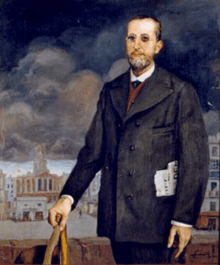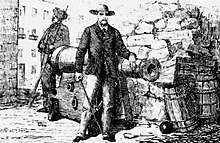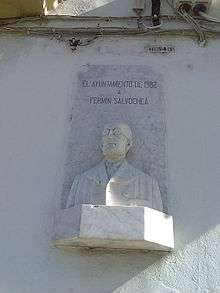Fermín Salvochea
Fermín Salvochea y Álvarez (1 March 1842, in Cádiz – 27 September 1907, in Cádiz) was a mayor of the city of Cádiz and a president of the province of Cádiz. He was one of the main propagators of anarchist thought in that area in the late 19th century and is considered to be "perhaps the most beloved figure in the Spanish Anarchist movement of the 19th century".[1][2] Being a prominent republican, in 1871, he joined the First International. In 1873, he was elected president of the administrative committee of Cádiz Province.

Ideologically, he was influenced by Bradlaugh, Owen and Paine, whose works he had studied during his stay in England, and Kropotkin, whom he read later. In Spain he had contact with the anarchist thinkers and members of the Bakuninist Alliance, including Anselmo Lorenzo and Francisco Mora (anarchist).[1]
Biography

He was born in the Plaza de las Viudas to a family originally from Navarre. His paternal grandfather had established himself in Cádiz after emigrating from Navarre, to engage in commerce. His mother, Pilar Alvarez, was the cousin of [[Juan Álvarez
Following the traditions of the mercantile bourgeoisie of Cádiz to which the family belonged, when Salvochea was 15 his father sent him to England to become familiar with the ways of commerce. Fermín stayed in London and Liverpool for five years. But he was more devoted to studying the social problems of the time than the mercantile trade. He read the works of Owen, Paine and Berdlow.[1] He returned to Cádiz at 21, with a yearning to reform society, influenced by the doctrines of utopian socialism. He was also known for his tolerance and generosity.
After the Glorious Revolution, he was appointed head of one of the Battalions of Voluntarios de la Libertad in Cádiz. Actively participating in the revolution of 1868 in Cádiz, he was imprisoned. Released in 1869 he organized armed resistance against the government in the Sierra de Cádiz. But after being defeated by the government troops, he took refuge in Gibraltar. In 1871, thanks to the amnesty granted by Amadeo of Savoy, he returned to Cádiz. It is believed that it was at this time when he joined the First International, and he continued to support Republican ideas.
Being the leader of the Canton of Cádiz at the end of Cantonal Revolution, he was captured by the troops of General Pavia in Seville, tried and sentenced to life imprisonment. He remained for several years in detention in Peñón de Vélez de la Gomera and Ceuta. After refusing the pardon that he was granted by the council of Cádiz in 1883, he escaped to Morocco. Disenchanted by politics and parliamentarianism, it was during his years in prison and in exile (after his escape which took him to France), when he firmly became an anarchist of the anarchist communism school.[1]
Upon the death of Alfonso XII he was granted amnesty again and he returned to Cádiz, where he founded the newspaper El Socialismo, which published, among other items, the anarchist communist ideas of Kropotkin, thus introducing anarcho-communist thinking among the Spaniards,[1] many of whom were still attached to the collectivist anarchism. He thus encouraged internal debate. He organized the first May Day in Cádiz in 1890, which was then followed as a custom during the following years. He was again thrown in jail after the Agrarian Mutiny of Jerez de la Frontera, in 1892, thanks to a false testimony that caused him to be sentenced to 12 years in prison. An amnesty allowed him out of prison in 1899, and he returned again to Cádiz (where he met Pedro Vallina), and then soon departed to Madrid. Both of them worked with the magazine, La Revista Blanca run by the libertarians Joan Montseny and Soledad Gustavo, and generally participated in the anarchist activities of the capital. He was present at and supported the general strike of 1902.
During his life, he often renounced his heritage and family possessions and delivered it to the most needy. He lived in destitution and away from material luxury.[1]
Back in Cádiz, his last work was a translation of Kropotkin's Fields, Factories and Workshops. He died on 28 September 1907, after falling from the table that was serving as his bed. His funeral was a great demonstration of popular grief with about fifty thousand people, mostly workmen from the Cádiz and Jerez areas, in attendance.[1]
Legacy

Bookchin describes Salvochea's life thus:
This was a life that spanned the Anarchist movement from its beginning to the point where it entered an entirely new phase - the period of Anarchosyndicalism
The anarchist historian Manuel Buenacasa Tomeo called Salvochea "nuestro santo mayor" - "our greatest saint". His image as a "saintly" figure is in contrast to some of the other elements in the anarchist movement like Paulino Pallás who employed more terroristic tactics.[1]
Cultural image
Blasco Ibáñez created a character based on Salvochea in his novel "La Bodega", called Fernando Salvatierra. During the Second Spanish Republic, while the people of Cádiz were discussing the erection of a monument in his honor, a village in the province of Huelva named itself after Salvochea. In the early parts of the Spanish Civil War, one of the columns that fought in Aragon was named after him. In 1980, the democratic council of Cádiz, dedicated a street and a bust to Salvochea. in 2017, Cádiz-born fantasy novelist Jesús Cañadas made him the central figure in his novel Las tres muertes de Fermín Salvochea [The Three Deaths of Fermín Salvochea] (Roca Editorial.[3]) He figures on a recurring basis, from local traditions, in the Carnival in the city of Cádiz. A fraction of the Cádiz CF calls itself the "Salvochea Column". At present, the Ateneo Libertario, a primary school (CEIP), and a neighbourhood association in Cádiz all bear his name . The Loreto neighbourhood association erected a commemorative bust paid for by popular subscription. To this day, flowers are placed on his grave in Cádiz.
After his death, he was popularly known, in antithesis to the Catholicism dominant in that region, as "The Saint of Anarchy."
See also
- Anarchism in Spain
- List of mayors of Cádiz
Notes
- Bookchin, Murray (1998). The Spanish Anarchists. pp. 111-114
- FERMÍN SALVOCHEA ÁLVAREZ, CGT. BIOGRAFÍAS (English translation), accessed April 2009
- "Roca Editorial". www.rocalibros.com.
References
- Bookchin, Murray (1998). The Spanish Anarchists. AK Press. ISBN 1-873176-04-X.
Further reading
| Wikimedia Commons has media related to Fermín Salvochea. |
- Mato Ortega, JM y, Moreno Tello, S (coord) (2009). Diputación de Cádiz (ed.). Fermín Salvochea (1842-1907) Historia de un Interanacionalista. Una herramienta para el futuro.
- Rocker, Rudolf. Fermín Salvochea.
- Termes, Josep (1977). Critical (ed.). Anarquismo y Sindicalismo en España.
- Parrilla, Pedro (1983). El Cantonalismo Gaditano. Caja de Ahorros de Cádiz.
- Vallina, Pedro (1954). Crónica de un revolucionario. Con trazos de la vida de Fermín Salvochea. SOV CNT-AIT Cádiz, 2007.
- de Puelles, Fernando (1984). Fermín Salvochea, república y anarquismo. Seville.
- AAVV (1987). Fermín Salvochea. Un anarquista entre la leyenda y la Historia. Cádiz, 2009.
- Iñiguez, Miguel: "Enciclopedia histórica del anarquismo español", Asociación Isaac Puente, Vitoria, 2008.